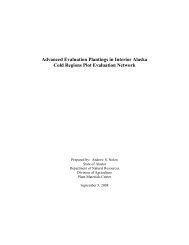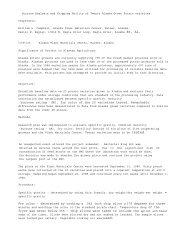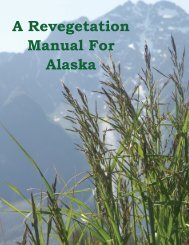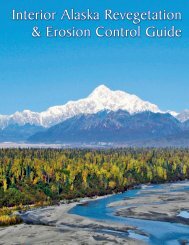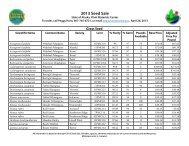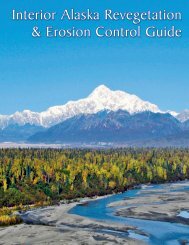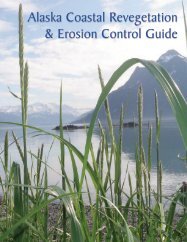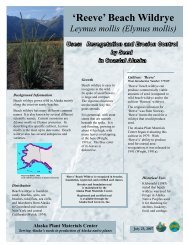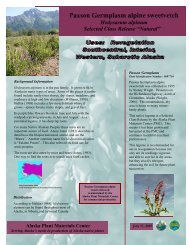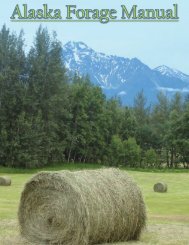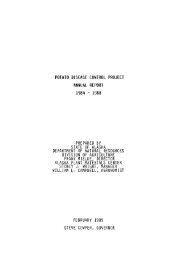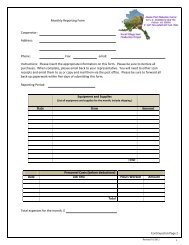Alaska Forage Manual - Alaska Plant Materials Center - State of ...
Alaska Forage Manual - Alaska Plant Materials Center - State of ...
Alaska Forage Manual - Alaska Plant Materials Center - State of ...
You also want an ePaper? Increase the reach of your titles
YUMPU automatically turns print PDFs into web optimized ePapers that Google loves.
Photo: User Rasbak (Wikimedia.org)<br />
FIELD PEA<br />
Field Pea<br />
Pisum sativum (L.)<br />
Description<br />
Mature Field Pea plant<br />
Pisum sativum, Field Pea is an annual legume that is prostrate<br />
(flat growing) by nature. When intercropped with a grass or<br />
small grain, however, the legume can reach a height <strong>of</strong> 60<br />
to 120 centimeters (24 to 48 inches), depending on variety.<br />
Intercropping allows Field Pea to wrap itself around the<br />
secondary crop allowing it to grow upward. A single leaf<br />
consists <strong>of</strong> one to three pairs <strong>of</strong> leaflets that are terminated<br />
with a branched tendril (used for climbing). Field Pea leaves<br />
are usually pale green with white blotches. This legume has a<br />
large round shaped seed and generally produces 1,600 to 5,000<br />
seeds per pound <strong>of</strong> seed, depending upon variety. Seedling<br />
vigor is low to moderate and seeds should be inoculated with<br />
proper bacterium when applicable.<br />
Uses<br />
Livestock: Field Pea is used for pasture, hay, silage and/or<br />
green cut. It is excellent forage and is highly palatable to all<br />
classes <strong>of</strong> livestock. This legume is <strong>of</strong>ten intercropped with<br />
annual grasses or oats to obtain optimal nutrient and mineral<br />
requirements <strong>of</strong> livestock.<br />
Wildlife: Field Pea is highly palatable to a variety <strong>of</strong> wildlife<br />
such as deer, elk, moose and bison. It is also utilized as food<br />
and cover for small mammals, waterfowl and upland game<br />
birds.<br />
<strong>Forage</strong> Value<br />
Field Pea is highly palatable to all classes <strong>of</strong> livestock and<br />
wildlife. It produces 20 to 25 percent protein on average and<br />
contains high levels <strong>of</strong> carbohydrates. This legume generally<br />
produces greater than 85% total digestible nutrients, with low<br />
fiber content. Intercropped with annual grasses or small grains,<br />
Field Pea can increase combined protein levels two to four<br />
times higher than with grass or small grains in monoculture.<br />
Field Pea has a moderate bloating factor, compared to other<br />
legumes, and should be fed with a grass or small grain forage<br />
to reduce the risk <strong>of</strong> bloating.<br />
Distribution and Adaptation<br />
Field Pea prefers cool, moist conditions and can be found<br />
growing throughout parts <strong>of</strong> <strong>Alaska</strong>, Canada, Greenland and<br />
the contiguous United <strong>State</strong>s. Field Pea is adapted to a variety<br />
<strong>of</strong> soil textures such as sandy loams, silts to heavy clays, and<br />
requires adequate drainage with a pH between 5.2 and 6.5.<br />
This legume cannot tolerate saline or droughty conditions.<br />
Culture<br />
Field Pea should be planted 1 to 3 inches deep in a moist firm<br />
seedbed. This promotes good seed to soil contact. Seeding<br />
rates depend greatly upon soil type, moisture, and location.<br />
Field Pea should be drill seeded when applicable, and is<br />
generally seeded at a rate <strong>of</strong> 190 lbs/acre, or 7 to 9 plants per<br />
square foot. This legume does not compete well with other<br />
species. A heavier seeding rate allows field pea to better<br />
compete with weeds.<br />
Appropriate fertilizer ratios depend upon soil type, chemistry,<br />
and location. Soil samples should be collected and analyzed<br />
before seeding. Field Pea requires phosphorus and potassium<br />
in relatively large amounts. Nitrogen is also necessary if<br />
planting in nutrient deprived soils. Over application <strong>of</strong><br />
nitrogen fertilizer can have adverse affects, however, reducing<br />
the potential <strong>of</strong> nitrogen fixation by plants. Fields should<br />
be irrigated when necessary. Irrigation in combination with<br />
fertilization can increase field productivity.<br />
Management<br />
Field Pea makes an excellent forage crop if properly managed.<br />
It can provide needed nitrogen for grasses and protein for<br />
livestock. Field Pea is not typically used for grazing, but rather<br />
it is used for silage or green chop. There are several pests that<br />
can affect Field Pea production, such as Mycosphaerella and<br />
Ascochyta. These fungi can result in poor plant performance<br />
and death if not managed. A preferred management tactic is<br />
to rotate field pea stands for several growing seasons, thus not<br />
allowing the fungus spores to persist. Fungi can survive for<br />
several years on Field Pea stubble and seed. Insects such as<br />
aphids, lygus bugs and grass hoppers can also affect Field Pea<br />
performance, though they are not usually a problem.<br />
75



